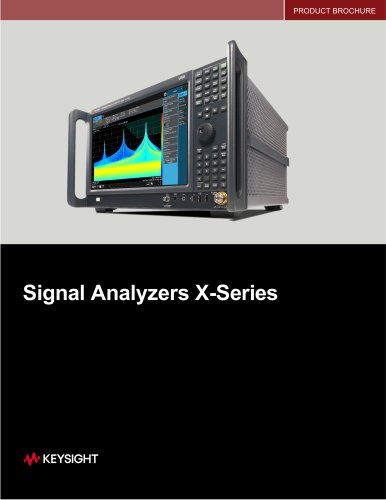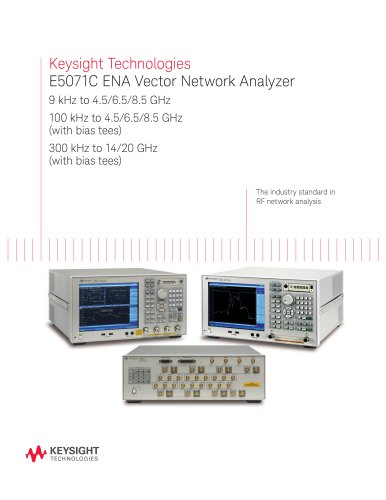
Catalog excerpts

Keysight Technologies Lightwave Catalog Optical-Electrical, Signal Generation, Complex Modulation Analysis
Open the catalog to page 1
02 | Keysight | Lightwave Catalog 2015 | Volume I Since more than 30 years, Keysight offers high-performance solutions to support you in building the high-speed communication network. Your experience and feedback helped us to continuously improve the product per- formance and quality, while significantly reducing the cost, especially when it comes to manufacturing optical Your needs and my confidence into our quality let me now offer our products with a 3-year warranty that's standard on all instruments worldwide. This combination of reliability and coverage brings you three key benefits:...
Open the catalog to page 2
03 | Keysight | Lightwave Catalog 2015 | Volume II Smart Setup The easiest way to setup your instrument The Keysight N4392A optical modulation analyzer (OMA) lets you see the true nature of complex modulated signals. Powered by the Keysight 89600 vector signal analysis software, you get deeper analysis and greater exibility. At a fraction of the cost, size and weight of a typical OMA, you can put the N4392A on your bench. Keysight N4392A Optical Modulation Analyzer Compact, portable and affordable Ready for 100G and beyond up to 46 Gbaud symbol rate 63 GSa/s sample rate
Open the catalog to page 3
04 | Keysight | Lightwave Catalog 2015 | Volume I Optical Modulation Analysis Tools The l-Q diagram (also called a polar or vector diagram) displays demodulated data, traced as the in-phase signal (I) on the x-axis versus the quadrature-phase signal (Q) on the y-axis. This tool gives deeper insight into the transition behavior of the signal, showing overshoot and an indication of whether the signal is bandwidth limited when a transition is not close to a straight line. Optical constellation diagram In a constellation diagram information is shown in a two-dimensional polar diagram,...
Open the catalog to page 4
05 | Keysight | Lightwave Catalog 2015 | Volume II Applications Optical Modulation Analysis Tools www.keysight.com/find/oma Error vector magnitude Error vector limit test The error vector time trace shows computed error vector between measured I-Q points and the reference I-Q points. The data can be displayed as error vector magnitude, error vector phase, the I component only or the Q component only. The error vector concept is a very powerful way to qualify the overall performance of an complex modulated signal. Testing against a limit with pass/fail indication covers all typical error...
Open the catalog to page 5
06 | Keysight | Lightwave Catalog 2015 | Volume II Applications Coherent Transmitter and Modulator Test www.keysight.com/find/n4392a Transmitter signal integrity characterization Transmitter laser Beam splitter X-plane modulator Y-plane modulator Polarization combiner Signal input – Transmitter signal performance veriication – Verify optimal alignment biasing circuits and skews – Transmitter vendor qualiication – Final pass fail test in manufacturing – Evaluation of transmitter components for best signal idelity Homodyne component characterization Transmitter laser – Component evaluation...
Open the catalog to page 6
07 | Keysight | Lightwave Catalog 2015 | Volume I Coherent Transmitter Test in Manufacturing Optical constellation diagram In a constellation diagram, signal information is shown only at the middle of a symbol time. This represents exactly the time stamp a real receiver will take to decide on the transmitted data. These points are commonly referred to as detec- tion decision-points- and are interpreted as the digital symbols. Constellation diagrams help identify effects like amplitude imbalance, quadrature error or phase noise just to mention some of them. For calculating the BER based on...
Open the catalog to page 7
08 | Keysight | Lightwave Catalog 2015 | Volume I Advanced research on OFDM Ugjr(f ]ntciv?l Gu.vd Upper Vuh.: jrrif i'. OFDM System Sample-Frequency Resemqte htodul *tion Like in a QPSK or M-QAM signal, an EVM (%rms) value can be calculated for each carrier and displayed along the horizontal axis. This gives an indication of modulation quality on all carriers. The individual bars describe the error vector of each symbol in that carrier, giving additional information about the distribution of OFDM high resolution spectrum An ODFM signal is a set of carriers that are orthogonal and very...
Open the catalog to page 8
09 | Keysight | Lightwave Catalog 2015 | Volume II Applications Research on Modulation Formats www.keysight.com/find/n4392a Customer conigurable APSK demodulator This new generic decoder allows the user to conigure a custom decoding scheme in accordance with the applied IQ signal. Up to 8 amplitude levels can be combined freely with up to 256 phase levels. This provides nearly unlimited freedom in research to deine and evaluate the transmission behavior of a proprietary modulation format. The setup is easy and straightforward. Some examples are shown below. Optical duobinary decoder In 40 G...
Open the catalog to page 9
10 | Keysight | Lightwave Catalog 2015 | Volume I To describe the quality of a complex modulated signal, there are a variety of parameters in place. Q offset (also called l/Q origin offset) ndicates the magnitude of the carrier feed through signal. When there is no carrierfeed through, IQ offset is zero Magnitude error Magnitude error is the difference in am- plitude between the measured signal and Phase error Phase error is the phase difference between the l/Q reference signal and the l/Q measured signal, as measured at the symbol time.
Open the catalog to page 10
11 | Keysight | Lightwave Catalog 2015 | Volume I Gain lmt> SNR (MER) - signal to noise ratio (modulation error ratio) SNR (MER) - Signal to Noise Ratio (Modulation Error Ratio) is the signal-to-noise ratio, where signal is the average symbol power of the transmitted waveform. The noise power includes any term that causes the symbol to deviate from its ideal state. Note: SNR and OSNR are only equal in Gaussian noise limited systems, when proper normalization is used (OSNR is typically Error vector and error vector magnitude as a global EVM %rms is a normalized measure of all error vectors...
Open the catalog to page 11All KEYSIGHT TECHNOLOGIES catalogs and technical brochures
-
Network Visibility Products
24 Pages
-
RF Products
20 Pages
-
Basic Instruments
34 Pages
-
InfiniiVision 2000 X-Series
31 Pages
-
Signal Analyzers X-Series
21 Pages
-
KeysightCare
8 Pages
-
FieldFox and Nemo Handy
4 Pages
-
Impedance and Network Analysis
42 Pages
-
E4990A Impedance Analyzer
12 Pages
-
Keysight N6780 Series
10 Pages
-
E5071C ENA Network Analyzers
18 Pages
-
Keysight Process Analysis
7 Pages
-
BenchVue Software
2 Pages
-
Keysight Process Analysis
7 Pages
-
PXI RF Switch Modules
2 Pages
-
I/O Hardware
18 Pages
-
Digital Multimeters
28 Pages
-
Data Acquisition - DAQ
32 Pages
-
PCIe Digitizers
8 Pages
-
2015 Optical Component Test
40 Pages
-
Power Products Catalog
215 Pages
-
N9000A CXA Signal Analyzer
2 Pages
-
Agilent 89600 VSA Software
8 Pages
-
X-Series
23 Pages
-
CXA X-Series
8 Pages
-
SOLUTION BROCHURE
6 Pages
-
Waveguide Power Sensors
2 Pages
-
Power Meters and Power Sensors
34 Pages
-
E7515A UXM Wireless Test Set
2 Pages
-
E5063A Network Analyzer
8 Pages
-
N9320B RF Spectrum Analyzer
12 Pages
-
E5052B Signal Source Analyzer
21 Pages
-
N9038A MXE EMI Receiver
22 Pages
-
RDX Test Solutions for DigRF
17 Pages
-
M9252A DigRF Host Adapter
2 Pages
-
M9502A and M9505A
12 Pages
-
Oscilloscopes
16 Pages
-
Agilent Power Products
31 Pages
-
LIGHTWAVE CATALOG VOLUME I 2013
40 Pages
-
U4301A PCIe Analyzer
7 Pages
-
N9030A PXA Signal Analyzer
32 Pages
Archived catalogs
-
Agilent Technologies - Catalog
40 Pages


































































































































































